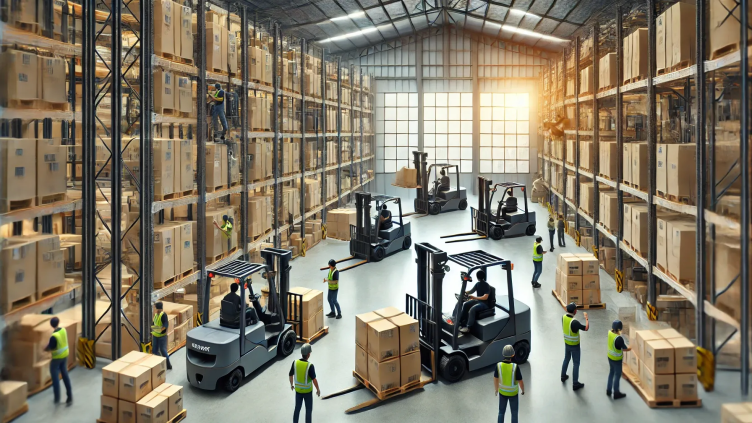By 2030, the global forklift market size will surge from $85.19 billion to $125.42 billion and the transformation happening on warehouse floors today reveals why this 6.7% annual growth rate might just be conservative.
The Forklift Market is experiencing a fundamental reinvention driven by forces that warehouse managers couldn’t have predicted five years ago. E-commerce’s relentless expansion, autonomous technology breakthroughs, and sustainability mandates are converging to reshape how goods move through the global supply chain. For Forklift Companies and logistics professionals, understanding this shift isn’t optional anymore.
What’s fueling this remarkable trajectory? The answer lies deeper than surface-level automation trends.
The Numbers Tell a Compelling Story
The Forklift Market Size expansion from USD 85.19 billion in 2024 to USD 125.42 billion by 2030 represents more than incremental growth. According to comprehensive research by MarketsandMarkets, this 6.7% compound annual growth rate signals a fundamental transformation in material handling infrastructure worldwide.
The Forklift Industry landscape has shifted dramatically. Where traditional combustion-powered units once dominated, electric forklifts powered by lithium-ion batteries now command unprecedented market share. Class 1 and Class 3 electric forklifts are experiencing particularly robust adoption across third-party logistics providers, e-commerce fulfillment centers, and automotive manufacturing facilities.
What’s Driving the Market Forward
E-Commerce Demands Smarter Solutions
The explosion of online retail created unprecedented pressure on warehouse operations. Fulfillment centers now require equipment that can operate 24/7 with minimal downtime. Electric forklifts, especially those equipped with fast-charging lithium-ion batteries answer this demand while slashing operational costs by up to 60% compared to internal combustion engine alternatives.
Autonomous Technology Enters Prime Time
Perhaps no trend better illustrates the Forklift Market evolution than the surge in autonomous and semi-autonomous units. These intelligent machines navigate warehouse environments independently, communicate with warehouse management systems in real-time, and optimize material flow with precision impossible for human operators alone.
Sustainability Becomes Non-Negotiable
Emission regulations tightening across North America, Europe, and Asia Pacific have transformed electric propulsion from a nice-to-have into a must-have. Companies aren’t just choosing electric forklifts for environmental credentials, they’re discovering these units deliver superior total cost of ownership through reduced maintenance, longer operational lifespans, and elimination of fuel price volatility.
Regional Dynamics Reshape Market Share
Forklift Market Share distribution reveals fascinating geographic patterns. Asia Pacific dominates both production and consumption, driven by China’s manufacturing might and India’s rapidly expanding logistics infrastructure. Europe leads in autonomous forklift adoption, reflecting the region’s aggressive push toward Industry 4.0 integration. North America shows particularly strong growth in the 3PL sector, where operators demand maximum flexibility and reliability.
The Competitive Landscape Intensifies
Leading Forklift Companies are locked in fierce competition for market position. Toyota Industries Corporation, KION Group AG, Mitsubishi Logisnext, and Jungheinrich AG continue leveraging their established dealer networks while simultaneously racing to develop next-generation autonomous and AI-powered solutions. Meanwhile, new entrants focused exclusively on electric and autonomous segments are disrupting traditional business models.
The competitive battlefield has expanded beyond product specifications to encompass total fleet management solutions, predictive maintenance platforms, and integrated warehouse automation ecosystems. Companies offering comprehensive digital solutions alongside physical equipment are capturing outsized share growth.
Technology Convergence Creates New Opportunities
The Forklift Industry stands at the intersection of multiple technological revolutions. Internet of Things sensors provide real-time telemetry on equipment health and utilization. Artificial intelligence optimizes routing and task allocation. Advanced battery management systems maximize runtime while extending battery lifespan. Fleet management software delivers unprecedented visibility into operations.
This technology convergence means modern forklifts function less as isolated pieces of equipment and more as integrated nodes within intelligent warehouse networks. For industry stakeholders, the implications extend far beyond equipment purchases to encompass workforce training, infrastructure investment, and strategic planning.
What Industry Professionals Need to Know Now
The Forklift Market transformation presents both opportunities and challenges for warehouse operators, fleet managers, and logistics executives:
Investment Timing Matters: With electric forklift technology maturing rapidly and prices declining, the total cost of ownership calculation has shifted dramatically in favor of electric units. However, the autonomous segment remains in relatively early stages, suggesting patient observers might benefit from waiting for technology refinement.
Infrastructure Requirements: Transitioning to electric and autonomous fleets requires substantial charging infrastructure investment and facility modifications. Smart operators are conducting comprehensive ROI analyses that account for energy costs, space utilization, and operational flexibility.
Workforce Implications: Autonomous and semi-autonomous forklifts don’t eliminate human workers they transform their roles. Forward-thinking companies are investing heavily in workforce retraining, emphasizing supervision, troubleshooting, and fleet management skills.
Looking Ahead: The 2030 Landscape
By the decade’s end, the Forklift Market Size will have grown by nearly 50% from 2024 levels. This expansion reflects not just more forklifts, but fundamentally different machines performing in fundamentally different ways.
Expect continued electric propulsion dominance, with lithium-ion batteries becoming the overwhelming standard. Anticipate autonomous and semi-autonomous units transitioning from novelty to normalcy in Class 1 and Class 3 categories. Watch for continued consolidation among traditional Forklift Companies while specialized autonomous providers carve out defensible niches.
The warehouses of 2030 will hum with intelligent, interconnected equipment that optimizes itself continuously, requires minimal human intervention for routine tasks, and delivers operational efficiency impossible with today’s technology. For industry stakeholders willing to embrace this transformation, the opportunities are substantial.
For comprehensive market forecasts, detailed company profiles, and exclusive analysis of the forklift market across all segments, classes, and regions, explore the full research report from MarketsandMarkets. The report provides granular insights into market dynamics, competitive landscapes, and strategic opportunities shaping the industry through 2030.

